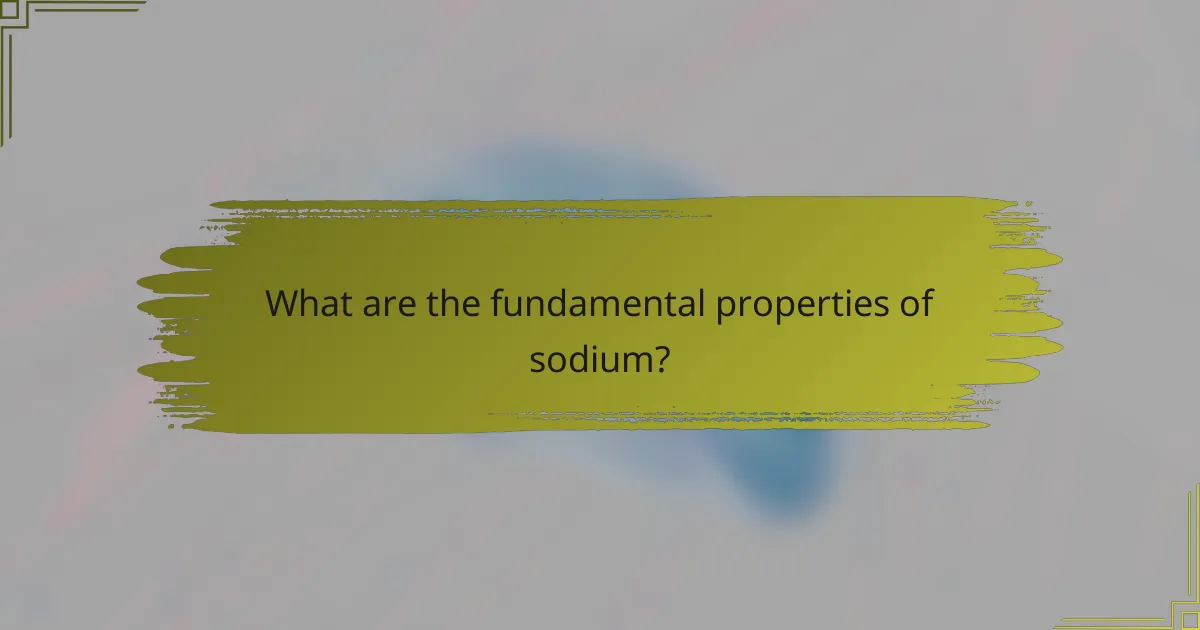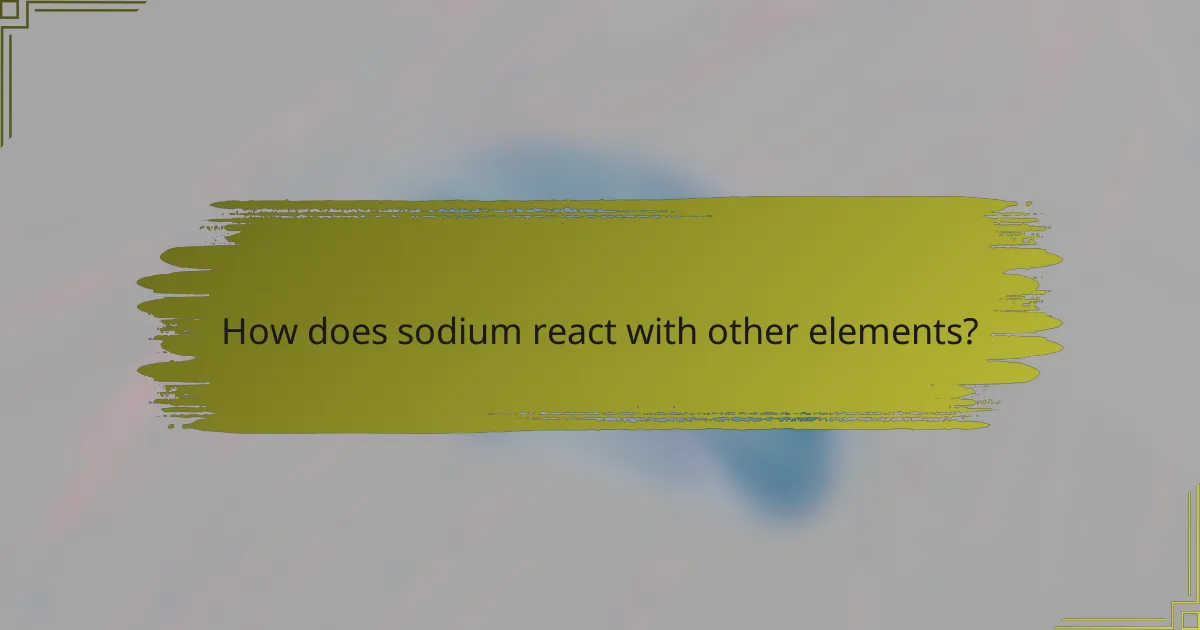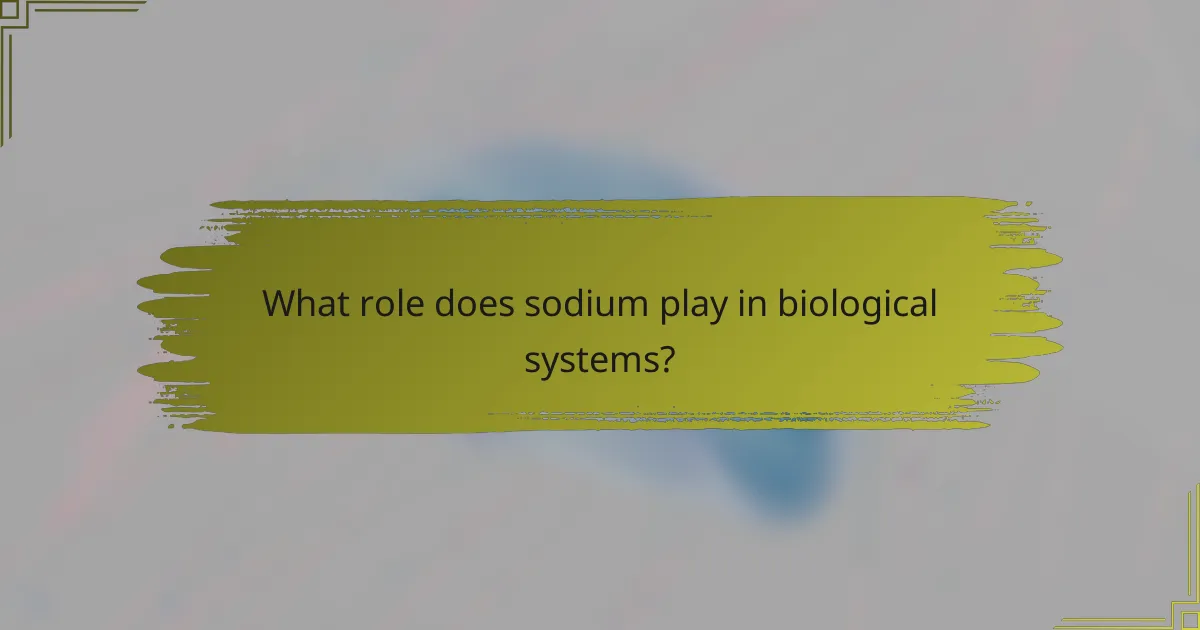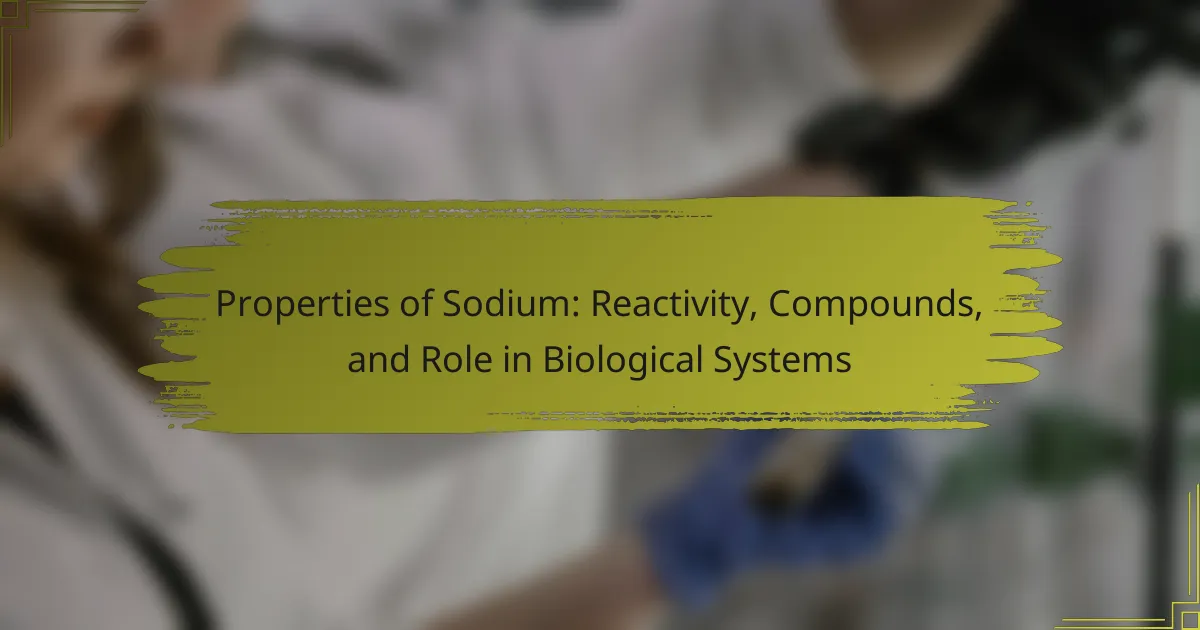
What are the fundamental properties of sodium?
Sodium is a chemical element with the symbol Na and atomic number 11. It is a soft, silvery-white, highly reactive metal. Sodium belongs to the alkali metals group in the periodic table. It has a low melting point of 97.79°C and a boiling point of 883°C. Sodium readily reacts with water to produce hydrogen gas and sodium hydroxide. This reaction is exothermic and can be explosive. Sodium is essential for biological functions, particularly in nerve impulse transmission and muscle contraction. It is commonly found in nature as sodium chloride, or table salt. Sodium’s unique properties include its high reactivity and its role in maintaining osmotic balance in living organisms.
How does sodium’s atomic structure influence its properties?
Sodium’s atomic structure significantly influences its properties due to its single valence electron. This electron is located in the outermost shell of the sodium atom. The presence of one valence electron makes sodium highly reactive. Sodium tends to lose this electron easily to achieve a stable electronic configuration. As a result, sodium readily forms positive ions (Na+). This ionization is a key factor in its ability to participate in chemical reactions. Sodium’s reactivity is evident in its vigorous reactions with water, producing hydrogen gas and sodium hydroxide. The atomic structure also contributes to sodium’s metallic properties, such as electrical conductivity.
What is the significance of sodium’s electron configuration?
Sodium’s electron configuration is significant because it determines its chemical properties and reactivity. Sodium has an electron configuration of 1s² 2s² 2p⁶ 3s¹. This configuration shows that sodium has one electron in its outermost shell. The presence of this single valence electron makes sodium highly reactive. Sodium readily loses this electron to achieve a stable electronic configuration, similar to that of noble gases. This tendency to lose an electron leads to the formation of sodium ions (Na⁺). Sodium’s reactivity is fundamental in forming compounds, such as sodium chloride (NaCl). The electron configuration directly influences sodium’s role in biological systems, particularly in nerve transmission and muscle contraction.
How does sodium’s position in the periodic table affect its behavior?
Sodium’s position in the periodic table as an alkali metal influences its behavior significantly. Alkali metals are located in Group 1, characterized by having one electron in their outermost shell. This single electron makes sodium highly reactive, as it readily loses this electron to achieve a stable electron configuration. Sodium’s reactivity increases down the group due to decreasing ionization energy. As a result, sodium reacts vigorously with water, producing hydrogen gas and sodium hydroxide. This behavior is evidenced by its violent reaction with moisture in the air. Additionally, sodium forms ionic compounds, such as sodium chloride, through electron transfer with nonmetals. The position of sodium also affects its physical properties, making it soft and low in density compared to other metals.
What are the physical characteristics of sodium?
Sodium is a soft, silvery-white metallic element. It is highly reactive and belongs to the alkali metals group. Sodium has a melting point of 97.79 °C and a boiling point of 883 °C. The atomic number of sodium is 11, and its atomic mass is approximately 22.99 g/mol. It is less dense than water, with a density of 0.97 g/cm³. Sodium is typically found in a solid state at room temperature. It exhibits a bright metallic luster when freshly cut. Sodium reacts vigorously with water, producing hydrogen gas and sodium hydroxide.
What are the observable properties of sodium metal?
Sodium metal is a soft, silvery-white metallic element. It is highly reactive and can tarnish quickly when exposed to air. Sodium has a low melting point of 97.79 °C. It can be easily cut with a knife, revealing a shiny surface. When in contact with water, sodium reacts vigorously, producing hydrogen gas and heat. This reaction can ignite the hydrogen. Sodium is less dense than water, allowing it to float. The element has a characteristic metallic luster when freshly cut.
How does sodium react to different environmental conditions?
Sodium reacts vigorously with water and moisture in the air. When sodium comes into contact with water, it produces sodium hydroxide and hydrogen gas, resulting in an exothermic reaction. This reaction can lead to flames and explosions due to the rapid release of hydrogen gas. Sodium also reacts with oxygen, forming sodium oxide when exposed to air. In dry environments, sodium remains relatively stable but can still react under certain conditions. In humid environments, sodium’s reactivity increases due to the presence of moisture. The elemental form of sodium is highly reactive and must be stored under oil to prevent reactions with moisture and air.

How does sodium react with other elements?
Sodium reacts vigorously with other elements, particularly nonmetals. It readily loses one electron to form a positive ion (Na+). This characteristic makes sodium highly reactive, especially with halogens like chlorine. When sodium reacts with chlorine, it forms sodium chloride, a common salt. Sodium also reacts with oxygen, producing sodium oxide. The reaction with water is particularly notable; sodium reacts explosively, generating hydrogen gas and sodium hydroxide. The high reactivity of sodium is due to its low ionization energy, which facilitates electron loss. This behavior is consistent with its position in Group 1 of the periodic table.
What types of reactions does sodium undergo?
Sodium undergoes several types of reactions, primarily including oxidation, reduction, and reaction with water. In oxidation reactions, sodium loses an electron to form sodium ions. This process occurs readily due to sodium’s high reactivity.
When sodium reacts with water, it produces sodium hydroxide and hydrogen gas. This reaction is highly exothermic and can be explosive. Sodium also reacts with halogens to form ionic compounds, such as sodium chloride.
In reduction reactions, sodium can donate electrons to reduce other substances. Sodium’s reactivity is a key characteristic, as it readily participates in these chemical processes.
How does sodium react with water and what are the implications?
Sodium reacts vigorously with water to produce sodium hydroxide and hydrogen gas. This reaction is highly exothermic, releasing a significant amount of heat. The heat generated can ignite the hydrogen gas, leading to explosions. Sodium hydroxide, a strong base, increases the pH of the water significantly. This reaction exemplifies sodium’s high reactivity due to its single valence electron. In practical terms, this property poses safety risks in industrial and laboratory settings. Proper precautions must be taken when handling sodium to prevent dangerous reactions.
What are the products formed when sodium reacts with halogens?
Sodium reacts with halogens to form sodium halides. The primary products are sodium chloride (NaCl) when sodium reacts with chlorine, sodium bromide (NaBr) with bromine, and sodium iodide (NaI) with iodine. This reaction typically occurs vigorously and releases energy. Sodium halides are ionic compounds, characterized by the transfer of an electron from sodium to the halogen. The resulting sodium ion (Na+) and halide ion (Cl-, Br-, I-) are held together by strong electrostatic forces. These products are commonly found in nature and have various applications in industry and everyday life.
What are the key sodium compounds and their uses?
Key sodium compounds include sodium chloride, sodium bicarbonate, sodium hydroxide, and sodium carbonate. Sodium chloride, commonly known as table salt, is used for seasoning and preserving food. Sodium bicarbonate, or baking soda, serves as a leavening agent in baking and as an antacid. Sodium hydroxide, also known as lye, is used in soap making and as a drain cleaner. Sodium carbonate, or soda ash, is utilized in glass manufacturing and as a cleaning agent. Each compound has specific applications based on its chemical properties and reactivity.
What are the most common sodium compounds?
The most common sodium compounds include sodium chloride, sodium bicarbonate, and sodium hydroxide. Sodium chloride, commonly known as table salt, is widely used for seasoning and preservation. Sodium bicarbonate, or baking soda, is utilized in cooking and as an antacid. Sodium hydroxide, also known as lye, is an important industrial chemical used in soap making and cleaning products. Other notable sodium compounds are sodium sulfate and sodium phosphate, which are used in detergents and fertilizers, respectively. These compounds are integral to various chemical processes and everyday applications.
How are sodium compounds utilized in various industries?
Sodium compounds are utilized in various industries for their diverse properties. In the chemical industry, sodium hydroxide is used for manufacturing soaps and detergents. Sodium bicarbonate serves as a leavening agent in food production. In the pharmaceutical sector, sodium salts are essential in drug formulations. The glass industry employs sodium carbonate to lower melting temperatures. Sodium chloride is crucial in food preservation and flavoring. Additionally, sodium compounds are used in water treatment to remove impurities. Their versatility makes them essential across multiple sectors.

What role does sodium play in biological systems?
Sodium plays a crucial role in biological systems as an essential electrolyte. It helps maintain fluid balance in cells and tissues. Sodium is vital for generating action potentials in neurons. This process is essential for nerve impulse transmission. Additionally, sodium regulates blood pressure and blood volume. It also supports muscle contraction and function. Sodium ions facilitate nutrient absorption in the intestines. These functions highlight sodium’s importance in maintaining homeostasis.
Why is sodium essential for human health?
Sodium is essential for human health because it plays a critical role in maintaining fluid balance and proper nerve function. It helps regulate blood pressure and volume. Sodium is also vital for muscle contraction and communication between nerves. The body requires a specific amount of sodium to function effectively. According to the Dietary Guidelines for Americans, adults should consume less than 2,300 mg of sodium per day. Insufficient sodium intake can lead to health issues such as hyponatremia, which can cause headaches, confusion, and muscle cramps. Thus, sodium is a key electrolyte necessary for various physiological processes.
What functions does sodium serve in cellular processes?
Sodium serves critical functions in cellular processes. It is essential for maintaining osmotic balance and fluid regulation within cells. Sodium ions help generate action potentials in nerve and muscle cells. This process is crucial for signal transmission and muscle contraction. Additionally, sodium plays a role in nutrient absorption in the intestines. It is involved in the sodium-potassium pump, which maintains cellular membrane potential. This pump exchanges sodium ions for potassium ions across the cell membrane. Proper sodium levels are vital for overall cellular homeostasis and function.
How does sodium contribute to maintaining fluid balance in the body?
Sodium helps maintain fluid balance in the body by regulating osmotic pressure. Osmotic pressure is crucial for fluid movement between cells and bloodstream. Sodium ions attract water, which helps retain fluids in the body. This process is essential for hydration and overall cellular function. The kidneys play a vital role in sodium balance. They filter sodium and adjust its levels based on the body’s needs. This regulation ensures that fluid levels remain stable. An imbalance in sodium can lead to dehydration or edema. Thus, sodium is critical for maintaining homeostasis in body fluids.
What are the consequences of sodium deficiency or excess?
Sodium deficiency can lead to hyponatremia, causing symptoms like headache, confusion, and fatigue. Severe cases may result in seizures or coma. Excess sodium intake is linked to hypertension, increasing the risk of cardiovascular diseases. High sodium levels can also lead to kidney damage over time. The body requires sodium for fluid balance and nerve function. The recommended daily intake is about 2,300 mg for most adults. Maintaining sodium levels is crucial for overall health.
What health issues are associated with low sodium levels?
Low sodium levels can lead to several health issues. These issues include hyponatremia, which is a condition characterized by low sodium concentration in the blood. Symptoms of hyponatremia can range from mild to severe. Mild symptoms include headache, nausea, and confusion. Severe cases may result in seizures, coma, or even death. Low sodium can disrupt fluid balance in cells, causing swelling. This swelling can affect brain function and lead to neurological complications. Additionally, low sodium can impact muscle function, resulting in cramps or weakness. It is essential to maintain proper sodium levels for overall health and bodily functions.
How can excessive sodium intake affect health?
Excessive sodium intake can lead to serious health issues. High sodium levels can cause hypertension, or high blood pressure. This condition increases the risk of heart disease and stroke. Studies show that reducing sodium intake can lower blood pressure. The American Heart Association recommends a limit of 2,300 mg per day. Most adults consume over this amount. Excessive sodium can also lead to kidney damage over time. The kidneys struggle to filter out excess sodium, leading to fluid retention. This can increase the workload on the cardiovascular system.
What practical tips can help manage sodium intake?
To manage sodium intake, choose fresh foods over processed ones. Processed foods often contain high sodium levels. Read nutrition labels to check sodium content. Aim for less than 2,300 mg of sodium per day. Use herbs and spices instead of salt for flavoring. Cooking at home allows better control over sodium levels. Limit high-sodium condiments like soy sauce and ketchup. Opt for low-sodium versions of canned and packaged products. Drinking plenty of water can help balance sodium levels in the body.
How can individuals monitor their sodium consumption effectively?
Individuals can monitor their sodium consumption effectively by tracking their daily intake through food labels and meal planning. Food labels provide specific sodium content per serving, allowing for precise tracking. Individuals should aim to consume less than 2,300 mg of sodium per day, as recommended by health organizations. Keeping a food diary can also help in monitoring sodium intake over time. Utilizing mobile apps designed for nutritional tracking can simplify this process. These apps often have databases of food items and their sodium content. Regularly reviewing dietary habits can identify high-sodium foods that may need to be reduced. Research indicates that maintaining awareness of sodium intake can lead to better dietary choices and improved health outcomes.
What dietary choices can help maintain a healthy sodium balance?
Incorporating fresh fruits and vegetables helps maintain a healthy sodium balance. These foods are naturally low in sodium and high in potassium. Potassium helps counteract the effects of sodium in the body. Consuming whole grains also supports sodium balance. Whole grains provide essential nutrients and fiber without high sodium levels. Limiting processed foods is crucial as they often contain high sodium content. Reading nutrition labels can aid in identifying sodium levels in foods. Drinking plenty of water helps dilute sodium concentrations in the body. Balanced meals with lean proteins contribute to overall sodium regulation.
Sodium, represented by the symbol Na and atomic number 11, is a highly reactive alkali metal known for its essential role in biological systems. The article explores sodium’s fundamental properties, including its atomic structure, reactivity with water and other elements, and its significance in forming various compounds such as sodium chloride and sodium hydroxide. Additionally, it highlights sodium’s critical functions in maintaining fluid balance, nerve impulse transmission, and muscle contraction, while also addressing the health implications of sodium deficiency and excess. Practical tips for managing sodium intake and dietary choices to maintain a healthy sodium balance are also discussed.
